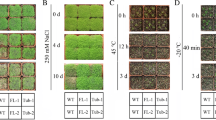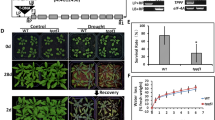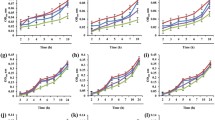Abstract
Key message
The Arabidopsis Tubby-like protein (TLP) encoding gene, AtTLP2, plays intricate roles during ABA-dependent abiotic stress signalling, particularly salt and dehydration stress responses.
Abstract
TLPs (Tubby-like proteins) are a small group of eukaryotic proteins characterized by the presence of a Tubby domain. The plant TLPs have been widely shown to play important roles during abiotic stress signaling. In this study, we investigated the role of an Arabidopsis TLP, AtTLP2, in mediating abiotic stress responses. Both attlp2 null mutant and overexpression (OE) lines, in Arabidopsis, were studied which indicated the role of the gene also in development. The attlp2 mutant showed an overall dwarfism, while its overexpression caused enhanced growth. AtTLP2 localized to the plasma membrane (PM) and showed nuclear translocation in response to dehydration stress. The protein interacted with ASK1 and ASK2, but failed to show transactivation activity in yeast. AtTLP2 was transcriptionally induced by stress, caused by salt, dehydration and ABA. The attlp2 mutant was insensitive to ABA, but hypersensitive to oxidative stress at all stages of growth. ABA insensitivity conferred tolerance to salt and osmotic stresses at the germination and early seedling growth stages, but caused hypersensitivity to salt and drought stresses at advanced stages of growth. The OE lines were more sensitive to ABA, causing increased sensitivity to most stresses at the seed germination stage, but conferring tolerance to salt and osmotic stresses at more advanced stages of development. The stomata of the attlp2 mutant were less responsive to ABA and H2O2, while that of the OE lines exhibited greater sensitivity. Several ABA-regulated stress responsive marker genes were found to be downregulated in the mutant, but upregulated in the OE lines. The study establishes that AtTLP2 plays intricate roles in abiotic stress signaling, and the response may be largely ABA dependent.










Similar content being viewed by others
Data availability
The datasets generated in the current study are available from the corresponding author on reasonable request.
References
Antoni R, Gonzalez-Guzman M, Rodriguez L et al (2013) PYRABACTIN RESISTANCE1-LIKE8 plays an important role for the regulation of abscisic acid signaling in root. Plant Physiol 161:931–941. https://doi.org/10.1104/pp.112.208678
Bano N, Fakhrah S, Mohanty CS, Bag SK (2021) Genome-wide identification and evolutionary analysis of gossypium tubby-like protein (TLP) gene family and expression analyses during salt and drought stress. Front Plant Sci 12:1–24. https://doi.org/10.3389/fpls.2021.667929
Bao Y, Song WM, Jin YL et al (2014) Characterization of Arabidopsis tubby-like proteins and redundant function of AtTLP3 and AtTLP9 in plant response to ABA and osmotic stress. Plant Mol Biol 86:471–483. https://doi.org/10.1007/s11103-014-0241-6
Bao Y, Song WM, Pan J et al (2016) Overexpression of the NDR1/HIN1-Like gene NHL6 modifies seed germination in response to abscisic acid and abiotic stresses in arabidopsis. PLoS ONE 11:1–16. https://doi.org/10.1371/journal.pone.0148572
Bates LS (1973) Short communication. Rapid Determ Free Proline Water Stress Stud 207:205–207
Boggon TJ, Shan WS, Santagata S et al (1999) Implication of tubby proteins as transcription factors by structure- based functional analysis. Science 286:2119–2125. https://doi.org/10.1126/science.286.5447.2119
Brookbank BP, Patel J, Gazzarrini S, Nambara E (2021) Role of basal aba in plant growth and development. Genes (basel). https://doi.org/10.3390/genes12121936
Cai M, Qiu D, Yuan T et al (2008) Identification of novel pathogen-responsive cis-elements and their binding proteins in the promoter of OsWRKY13, a gene regulating rice disease resistance. Plant, Cell Environ 31:86–96. https://doi.org/10.1111/j.1365-3040.2007.01739.x
Clough SJ, Bent AF (1998) Floral dip: a simplified method for Agrobacterium-mediated transformation of Arabidopsis thaliana. Plant J 16:735–743. https://doi.org/10.1046/j.1365-313X.1998.00343.x
Dong MY, Fan XW, Pang XY, Li YZ (2019) Decrypting tubby-like protein gene family of multiple functions in starch root crop cassava. AoB Plants 11:1–13. https://doi.org/10.1093/aobpla/plz075
Du F, Xu JN, Zhan CY et al (2014) An obesity-like gene MdTLP7 from apple (Malus × domestica) enhances abiotic stress tolerance. Biochem Biophys Res Commun 445:394–397. https://doi.org/10.1016/j.bbrc.2014.02.005
Eisele JF, Fäßler F, Bürgel PF, Chaban C (2016) A rapid and simple method for microscopy-based stomata analyses. PLoS ONE 11:1–13. https://doi.org/10.1371/journal.pone.0164576
Fujii H, Zhu JK (2009) Arabidopsis mutant deficient in 3 abscisic acid-activated protein kinases reveals critical roles in growth, reproduction, and stress. Proc Natl Acad Sci U S A 106:8380–8385. https://doi.org/10.1073/pnas.0903144106
Fujii H, Verslues PE, Zhu JK (2011) Arabidopsis decuple mutant reveals the importance of SnRK2 kinases in osmotic stress responses in vivo. Proc Natl Acad Sci U S A 108:1717–1722. https://doi.org/10.1073/pnas.1018367108
Fujita M, Fujita Y, Maruyama K et al (2004) A dehydration-induced NAC protein, RD26, is involved in a novel ABA-dependent stress-signaling pathway. Plant J 39:863–876. https://doi.org/10.1111/j.1365-313X.2004.02171.x
Gonzalez-Guzman M, Pizzio GA, Antoni R et al (2012) Arabidopsis PYR/PYL/RCAR receptors play a major role in quantitative regulation of stomatal aperture and transcriptional response to abscisic acid. Plant Cell 24:2483–2496. https://doi.org/10.1105/tpc.112.098574
He F, Wang HL, Li HG et al (2018) PeCHYR1, a ubiquitin E3 ligase from Populus euphratica, enhances drought tolerance via ABA-induced stomatal closure by ROS production in Populus. Plant Biotechnol J 16:1514–1528. https://doi.org/10.1111/pbi.12893
Heath RL, Packer L (1968) Photoperoxidation in isolated chloroplasts. I. Kinetics and stoichiometry of fatty acid peroxidation. Arch Biochem Biophys 125:189–198. https://doi.org/10.1016/0003-9861(68)90654-1
Heikenwälder MF, Koritschoner NP, Pajer P et al (2001) Molecular cloning, expression and regulation of the avian tubby-like protein 1 (tulp1) gene. Gene 273:131–139. https://doi.org/10.1016/S0378-1119(01)00578-9
Jones HG, Sharp CS, Higgs KH (1987) Growth and water relations of wilty mutants of tomato (Lycopersicon esculentum Mill.). J Exp Bot 38:1848–1856. https://doi.org/10.1093/jxb/38.11.1848
Kim YY, Jung KW, Yoo KS et al (2011) A stress-responsive caleosin-like protein, AtCLO4, acts as a negative regulator of ABA responses in Arabidopsis. Plant Cell Physiol 52:874–884. https://doi.org/10.1093/pcp/pcr039
Ko JH, Yang SH, Han KH (2006) Upregulation of an Arabidopsis RING-H2 gene, XERICO, confers drought tolerance through increased abscisic acid biosynthesis. Plant J 47:343–355. https://doi.org/10.1111/j.1365-313X.2006.02782.x
Kong F, Ramonell KM (2022) Arabidopsis toxicos en levadura 12 modulates salt stress and ABA responses in Arabidopsis thaliana. Int J Mol Sci. https://doi.org/10.3390/ijms23137290
Kou Y, Qiu D, Wang L et al (2009) Molecular analyses of the rice tubby-like protein gene family and their response to bacterial infection. Plant Cell Rep 28:113–121. https://doi.org/10.1007/s00299-008-0620-z
Kumar D, Yusuf MA, Singh P, Sardar M, Sarin NB (2014) Histochemical detection of superoxide and H2O2 accumulation in Brassica juncea. Bio-protocol 4:1–4. https://doi.org/10.21769/BioProtoc.1108
Kuroda H, Yanagawa Y, Takahashi N et al (2012) A Comprehensive analysis of interaction and localization of Arabidopsis SKP1-LIKE (ASK) and F-Box (FBX) proteins. PLoS ONE. https://doi.org/10.1371/journal.pone.0050009
Lai CP, Shaw JF (2012) Interaction analyses of Arabidopsis tubby-like proteins with ASK proteins. Bot Stud 53:447–458
Lai CP, Lee CL, Chen PH et al (2004) Molecular analyses of the Arabidopsis TUBBY-like protein gene family. Plant Physiol 134:1586–1597. https://doi.org/10.1104/pp.103.037820
Li J, Li Y, Yin Z et al (2017) OsASR5 enhances drought tolerance through a stomatal closure pathway associated with ABA and H2O2 signalling in rice. Plant Biotechnol J 15:183–196. https://doi.org/10.1111/pbi.12601
Li S, Zhang J, Liu L et al (2020) SlTLFP8 reduces water loss to improve water-use efficiency by modulating cell size and stomatal density via endoreduplication. Plant Cell Environ 43:2666–2679. https://doi.org/10.1111/pce.13867
Li S, Wang Z, Wang F et al (2021) A tubby-like protein CsTLP8 acts in the ABA signaling pathway and negatively regulates osmotic stresses tolerance during seed germination. BMC Plant Biol 21:1–14. https://doi.org/10.1186/s12870-021-03126-y
Liao Y, Bai Q, Xu P et al (2018) Mutation in rice abscisic acid2 results in cell death, enhanced disease-resistance, altered seed dormancy and development. Front Plant Sci 9:1–15. https://doi.org/10.3389/fpls.2018.00405
Mukhopadhyay S, Jackson PK (2011) The tubby family proteins. Genome Biol 12:1–9. https://doi.org/10.1186/gb-2011-12-6-225
Nambara E, Okamoto M, Tatematsu K et al (2010) Abscisic acid and the control of seed dormancy and germination. Seed Sci Res 20:55–67. https://doi.org/10.1017/S0960258510000012
Nishimura N, Kitahata N, Seki M et al (2005) Analysis of ABA hypersensitive germination2 revealed the pivotal functions of PARN in stress response in Arabidopsis. Plant J 44:972–984. https://doi.org/10.1111/j.1365-313X.2005.02589.x
Nishimura N, Yoshida T, Kitahata N et al (2007) ABA-Hypersensitive Germination1 encodes a protein phosphatase 2C, an essential component of abscisic acid signaling in Arabidopsis seed. Plant J 50:935–949. https://doi.org/10.1111/j.1365-313X.2007.03107.x
Nishina PM, North MA, Ikeda A et al (1998) Molecular characterization of a novel tubby gene family member, TULP3, in mouse and humans. Genomics 54:215–220. https://doi.org/10.1006/geno.1998.5567
Pei L, Peng L, Wan X et al (2019) Expression pattern and function analysis of AtPPRT1, a novel negative regulator in ABA and drought stress responses in arabidopsis. Int J Mol Sci. https://doi.org/10.3390/ijms20020394
Porra RJ (2002) The chequered history of the development and use of simultaneous equations for the accurate determination of chlorophylls a and b. Photosynth Res 73:149–156
Reitz MU, Bissue JK, Zocher K et al (2012) The subcellular localization of tubby-like proteins and participation in stress signaling and root colonization by the mutualist Piriformospora indica. Plant Physiol 160:349–364. https://doi.org/10.1104/pp.112.201319
Risseeuw EP, Daskalchuk TE, Banks TW, Liu E, Cotelesage J, Hellmann H, Estelle M, Somers DE, Crosby WL (2003) Protein interaction analysis of SCF ubiquitin E3 ligase subunits from Arabidopsis. Plant J 34:753–767
Santagata S, Boggon TJ, Baird CL et al (2001) G-protein signaling through tubby proteins. Science 292:2041–2050. https://doi.org/10.1126/science.1061233
Shu K, Liu XD, Xie Q, He ZH (2016) Two faces of one seed: hormonal regulation of dormancy and germination. Mol Plant 9:34–45. https://doi.org/10.1016/j.molp.2015.08.010
Skubacz A, Daszkowska-Golec A, Szarejko I (2016) The role and regulation of ABI5 (ABA-insensitive 5) in plant development, abiotic stress responses and phytohormone crosstalk. Front Plant Sci 7:1–17. https://doi.org/10.3389/fpls.2016.01884
Song WM, Cheng ZH, Guo XT et al (2019) Overexpression of NHL6 affects seed production in transgenic Arabidopsis plants. Plant Growth Regul 88:41–47. https://doi.org/10.1007/s10725-019-00486-2
Wang M, Xu Z, Ahmed RI et al (2019) Tubby-like Protein 2 regulates homogalacturonan biosynthesis in Arabidopsis seed coat mucilage. Plant Mol Biol 99:421–436. https://doi.org/10.1007/s11103-019-00827-9
Wardhan V, Jahan K, Gupta S et al (2012) Overexpression of CaTLP1, a putative transcription factor in chickpea (Cicer arietinum L.), promotes stress tolerance. Plant Mol Biol 79:479–493. https://doi.org/10.1007/s11103-012-9925-y
Wardhan V, Pandey A, Chakraborty S, Chakraborty N (2016) Chickpea transcription factor CaTLP1 interacts with protein kinases, modulates ROS accumulation and promotes ABA-mediated stomatal closure. Sci Rep 6:1–16. https://doi.org/10.1038/srep38121
Xing L, Zhao Y, Gao J et al (2016) The ABA receptor PYL9 together with PYL8 plays an important role in regulating lateral root growth. Sci Rep 6:1–13. https://doi.org/10.1038/srep27177
Xu JN, Xing SS, Zhang ZR et al (2016) Genome-wide identification and expression analysis of the tubby-like protein family in the malus domestica genome. Front Plant Sci 7:1–12. https://doi.org/10.3389/fpls.2016.01693
Xu J, Xing S, Sun Q et al (2019) The expression of a tubby-like protein from Malus domestica (MdTLP7) enhances abiotic stress tolerance in Arabidopsis. BMC Plant Biol 19:1–8. https://doi.org/10.1186/s12870-019-1662-9
Yang Z, Zhou Y, Wang X et al (2008) Genomewide comparative phylogenetic and molecular evolutionary analysis of tubby-like protein family in Arabidopsis, rice, and poplar. Genomics 92:246–253. https://doi.org/10.1016/j.ygeno.2008.06.001
Yoshida T, Fujita Y, Sayama H et al (2010) AREB1, AREB2, and ABF3 are master transcription factors that cooperatively regulate ABRE-dependent ABA signaling involved in drought stress tolerance and require ABA for full activation. Plant J 61:672–685. https://doi.org/10.1111/j.1365-313X.2009.04092.x
Yoshida T, Obata T, Feil R et al (2019) The role of abscisic acid signaling in maintaining the metabolic balance required for arabidopsis growth under nonstress conditions. Plant Cell 31:84–105. https://doi.org/10.1105/tpc.18.00766
Zhang Y, He X, Su D et al (2020a) Comprehensive profiling of tubby-like protein expression uncovers ripening-related TLP genes in tomato (Solanum lycopersicum). Int J Mol Sci 21:1–14. https://doi.org/10.3390/ijms21031000
Zhang H, Liu D, Yang B et al (2020b) Arabidopsis CPK6 positively regulates ABA signaling and drought tolerance through phosphorylating ABA-responsive element-binding factors. J Exp Bot 71:188–203. https://doi.org/10.1093/jxb/erz432
Zhao Y, Zhang Z, Gao J et al (2018) Arabidopsis duodecuple mutant of PYL ABA receptors reveals PYL repression of ABA-independent SnRK2 activity. Cell Rep 23:3340-3351.e5. https://doi.org/10.1016/j.celrep.2018.05.044
Zhao H, Nie K, Zhou H et al (2020) ABI5 modulates seed germination via feedback regulation of the expression of the PYR/PYL/RCAR ABA receptor genes. New Phytol 228:596–608. https://doi.org/10.1111/nph.16713
Zheng Z, Xu X, Crosley RA et al (2010) The protein kinase SnRK2.6 mediates the regulation of sucrose metabolism and plant growth in arabidopsis. Plant Physiol 153:99–113. https://doi.org/10.1104/pp.109.150789
Acknowledgements
This research was funded by the Department of Science and Technology (DST), Government of India and J.C. Bose National Fellowship to JPK (SB/SR/JCB-13/2013) by the Science and Engineering Research Board (SERB), Government of India. Authors also acknowledge infrastructural support by the Department of Science and Technology (FIST and PURSE programmes), Government of India, and the University Grants Commission (UGC-SAP), New Delhi. NJ thanks the Council of Scientific and Industrial Research (CSIR), New Delhi, for providing financial assistance in the form of RA Fellowship.
Funding
JC BOSE NATIONAL FELLOWSHIP, SB/SR/JCB-13/2013, Jitendra Paul Khurana.
Author information
Authors and Affiliations
Contributions
NJ and JPK designed the research plan, NJ performed the experiments, analyzed the data and wrote the manuscript. JPK and PK critically supervised the progress of research, gave vital inputs in improvement of the research work and edited the manuscript. JPK funded the cost of the entire research through his grants. All authors have read and approved the manuscript.
Corresponding author
Ethics declarations
Conflict of interest
Authors declare no relevant financial or non-financial conflict of interest.
Additional information
Communicated by Zheng-Yi Xu.
Publisher's Note
Springer Nature remains neutral with regard to jurisdictional claims in published maps and institutional affiliations.
Supplementary Information
Below is the link to the electronic supplementary material.
299_2022_2953_MOESM1_ESM.pdf
Fig S1. PCR-based confirmation of the attlp2 mutant and the AtTLP2-OE lines. (A) depicts diagrammatically the AtTLP2 genomic DNA, exon organization and position of T-DNA insertion. The primers used for the PCR validation, using genomic DNA from mutant plants, have also been indicated. The combination of AtTLP2-specific FP and RP primers and T-DNA specific LBA primer produced PCR-bands of 1100 bp in the mutant and 2.1 kb in WT, proving homozygous mutation (B). (C) shows RT-PCR using AtTLP2 CDS-specific cFP and cRP primers, depicted in the figure, amplifying the 1100 bp AtTLP2-CDS in WT but no product in the mutant, confirming null mutation. (D) depicts the PCR-based confirmation of the AtTLP2-OE lines, using genomic DNA and NPT-II (750 bp) specific primers. Fig S2. Response of the attlp2 mutant and the AtTLP2-OE lines at 15-d old plant stage to ABA and oxidative stress. (A) depicts growth response of the OE lines to exogenous ABA (15 µM) and paraquat (2 µM) after 15 days on the stress media. Physiological measurements such as Fv/Fm values (B); total chlorophyll content (C); and final rosette diameter (D) after completion of 15 days on the stress media are graphically presented. The results are represented as mean ± SE, where n=3. The asterisk marks (*) indicate significant difference (P-value<0.05). Supplementary file1 (PDF 143 KB)
Rights and permissions
Springer Nature or its licensor (e.g. a society or other partner) holds exclusive rights to this article under a publishing agreement with the author(s) or other rightsholder(s); author self-archiving of the accepted manuscript version of this article is solely governed by the terms of such publishing agreement and applicable law.
About this article
Cite this article
Jain, N., Khurana, P. & Khurana, J.P. AtTLP2, a Tubby-like protein, plays intricate roles in abiotic stress signalling. Plant Cell Rep 42, 235–252 (2023). https://doi.org/10.1007/s00299-022-02953-z
Received:
Accepted:
Published:
Issue Date:
DOI: https://doi.org/10.1007/s00299-022-02953-z




